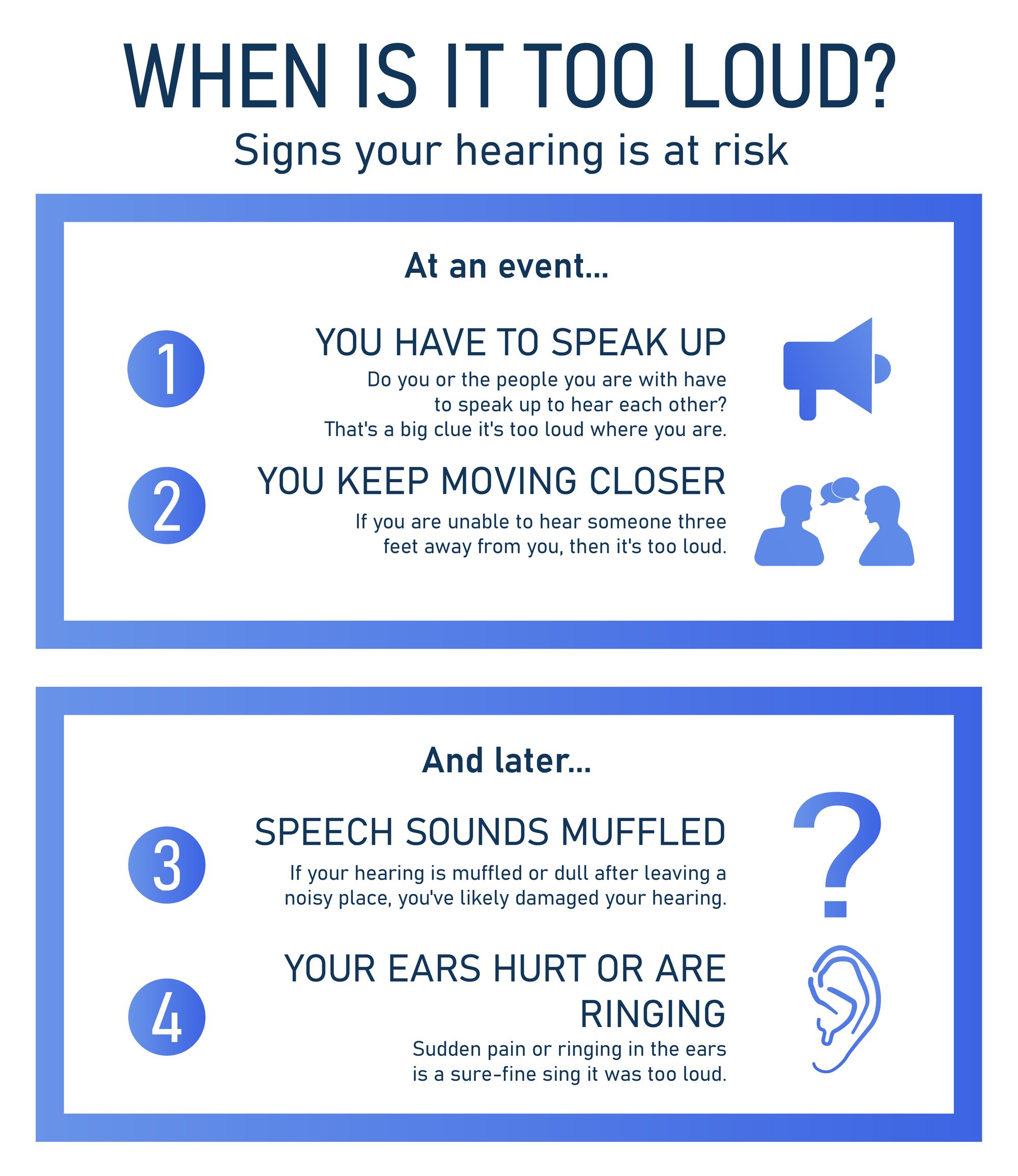- How Many Decibels Is Too Loud
- The Main Factors Influence The Severity Of Hearing Damage
2.1 Sound level (how loud the sound is)
2.2 Proximity (how close you are to the sound)
2.3 Time (how long you are exposed to it) - Common Sources Of Noise And Decibel Levels
3.1 Everyday activities
3.2 Events
3.3 Tools and more - When Is It Too Loud
- How To Protect Your Hearing
- Improve Hearing Using Decibel Pro App
To protect your hearing, you need to be mindful of the noise levels you are exposed to every day. Many times, noise levels at work, at home, or in our communities can exceed recommended levels and put us in danger of incurring hearing damage or even permanently losing our hearing.
To stay safe and protect your ears, read on to find out just how many decibels is too loud and what noise levels you should steer clear of to avoid noise-induced hearing damage and hearing loss.
How Many Decibels Is Too Loud?
The standard answer to ‘How many decibels is too loud?’ is 85 decibels. This is the decibel level researchers and authorities like the National Institute for Occupational Safety and Health (NIOSH) consider the recommended exposure level.
Based on this recommendation, you should avoid prolonged exposure (over 8 hours) or repeated exposure to noise levels above 85 decibels to prevent hearing damage and potential hearing loss.
The 85 dB recommended level is for work environments. For communities, the Environmental Protection Agency (EPA) recommends that you limit exposure to noise levels above 70 decibels. This is the recommended exposure level over a 24-hour period that allows you to prevent hearing loss.
The Main Factors that Influence the Severity of Hearing Damage
The severity of hearing damage depends on several factors such as the level of noise you are exposed to, your proximity to the sound source, and the duration of your exposure. To properly protect your hearing, you should take all of these factors into account.
Sound level (how loud the sound is)
The loudness of the sound you are exposed to determines how much hearing damage it can cause.
85 decibels is the noise level that is generally considered damaging to human hearing. However, to be on the safe side, you should consider any noise above 70 dB as being potentially dangerous to your hearing.
In cases when sound levels exceed 70 dB, you should use hearing protection solutions such as limiting exposure, moving away from the source, or using ear plugs or ear muffs.
Proximity (how close you are to the sound)
Sound intensity changes depending on how close you are to the source. A noise’s decibel level drops by 6 dB each time the distance from the source doubles.
The closer you are, the louder you will perceive the sound and, in many cases, moving away from the sound source is the easiest way to protect your hearing.
Time (how long you are exposed to it)
Another important aspect to take into account is how long you are exposed to a certain noise level. Exposure time critically impacts the severity of hearing damage.
85 decibel noise can damage your hearing if you are exposed to it for more than a few hours. On the other hand, noise levels exceeding 85 decibels can affect hearing faster.
Because the decibel scale is logarithmic, every 10 decibels you add multiplies the intensity of the sound 10 times. This means that 95 decibels is 10 times louder than 85 decibels and 100 times louder than a 75 decibel sound. Therefore, don’t take any noise level above 85 dB lightly.
For noise levels exceeding 100 decibels, you should limit your exposure to 15 minutes. For noise levels exceeding 110 dB, you should limit your exposure to 1 minute.
Common Sources of Noise and Decibel Levels
Many noises that we consider common and pay little attention to can cause hearing damage and lead to hearing loss.
To keep your hearing safe, consider measuring noise levels in your home, your workplace, and other surroundings to identify potential sources of loud sound. You can do this using a sound level meter or a sound level app like Decibel Pro.
Monitoring noise can help you pinpoint and avoid excessive levels and protect your ears from damage.
Everyday activities
We tend to not consider everyday activities like going to the movies or listening to music on our headphones dangerous. The truth is that many such activities are potentially damaging to your ears.
The good news is that many devices like our TVs and audio systems have volume limiting controls that we can use to set the maximum volume to a safe level.
Here are a few examples of decibel levels for everyday activities that exceed the recommended level of 85 dB and you should pay attention to:
- movie theaters 118 dB
- health clubs or aerobic studios 120 dB
- stereo systems (on headphones) 105 – 120 dB
- children’s toys 135 dB
- hairdryer 60-95 dB
- garbage disposal 70-95 dB
- food mixer or blender 80-90 dB
Events
When it comes to events, it’s the loudness that often attracts us to them. However, we should always take exposure to excessive noise levels seriously.
Here are some examples of decibel levels recorded at common events:
- music club or disco 110 dB
- concert 100 dB
- close-range shouting 100 dB
- rock concert 120 dB
- football game at a stadium 117 dB
- car races 130 dB
- events with fireworks 162 dB
Fortunately, just because we want to make sure we do not harm our hearing, this does not mean that we need to stop going to events. By controlling exposure time and using appropriate hearing protection, you can still enjoy listening to loud music and going to fun events.
Tools and more
Home is where we feel safest. That’s why it’s often easy to forget about hearing safety and consider that the activities we do in our home cannot be potentially damaging.
Still, if you take a look at the decibel levels below, you will see that things like power tools can easily exceed recommended limits:
- lawnmower 95 dB
- handsaw 85 dB
- electric drill 95 dB
- snow or leaf blower 100 dB
The same happens with the tools or machines we use at work or when firing guns. Here are some common decibel levels for these types of activities:
- tractor 90 dB
- factory machinery 100 dB
- power saw 110 dB
- chainsaw 120-125 dB
- pneumatic drills 120 dB
- jackhammer or power drill 130 dB
- rifle 163 dB
- handgun or shotgun 165-170 dB
When Is It Too Loud?

A simple way to know when noise is too loud is to watch out for these signs:
A simple way to know when noise is too loud is to watch out for these signs:
- During exposure
- you are having trouble hearing others over the background noise when using a normal conversation tone
- you need to raise your voice to be heard by others standing 3 feet away from you
- After-effects (once you leave the noisy environment)
- your hearing is muffled or dull
- your ears are ringing (tinnitus) or you experience pain in the ear.
How To Protect Your Hearing
Here are a few simple solutions for protecting your hearing:
Distance yourself from the source or walk away completely
One of the easiest things you can do to protect your hearing is to put some distance between yourself and the source of the loud sound. For instance, if you are at a concert, you can simply move further away from the speakers.
Turn down the volume
Indoor noise and listening to your TV or audio system at full volume can be particularly harmful. The rule of thumb you should follow to keep your hearing safe is to set the volume at 60% and not listen to loud audio or music for more than 60 minutes at a time.
Wear hearing protection
In some cases, you won’t be able to control the volume or walk away from the source. The solution then is to use hearing protectors. Make sure you choose the correct one for the type of sound you are exposed to and that it properly fits over or in your ear to offer full protection.
Improve Hearing Using the Decibel Pro App
Decibel Pro is a sound level meter app you can easily download on your iPhone or iPad and use for measuring the noise levels you are exposed to no matter where you are. It’s very easy to use, gives instant readings, and is a great way to know when noise levels are too loud.
It also includes a hearing test that you can regularly do from the comfort of your own home and identify any hearing damage early to prevent any further damage.
To learn more about the Decibel Pro app, click here.



